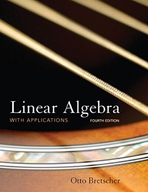Here is an infinite-dimensional version of Euclidean space: In the space of all infinite
Chapter 5, Problem 18(choose chapter or problem)
Here is an infinite-dimensional version of Euclidean space: In the space of all infinite sequences, consider the subspace 2 of square-summable sequences [i.e., those sequences (jcj , *2,...) for which the infinite series x\+x2~\---- converges]. For x and y in ti, we define11*11 = \A 2+*2 + '- x -y = x \ y i + x 2y2 + ---(Why does the series x\y\ + jC 2y2 H---- converge?) a. Check that x = (1, 3, ...) is in Z2, and find ||x ||. Recall the formula for the geometric series: 1 + a+ a2 +a3 -I-----= 1/(1 a), if 1 < a < 1. b. Find the angle between (1,0,0,...) and (\ 1 1 1 ^( 1, j , g , . . . ) . c. Give an example of a sequence (*1, *2,...) that converges to 0 (i.e., limn-^oo jc = 0) but does not belong to 2d. Let L be the subspace of 2 spanned by (1, j, 5, ...). Find the orthogonal projection of (1, 0, 0,...) onto L. The Hilbert space ii was initially used mostly in physics: Werner Heisenbergs formulation of quantum mechanics is in terms of i2. Today, this space is used in many other applications, including economics. (See, for example, the work of the economist Andreu Mas-Colell of the University of Barcelona.)
Unfortunately, we don't have that question answered yet. But you can get it answered in just 5 hours by Logging in or Becoming a subscriber.
Becoming a subscriber
Or look for another answer
